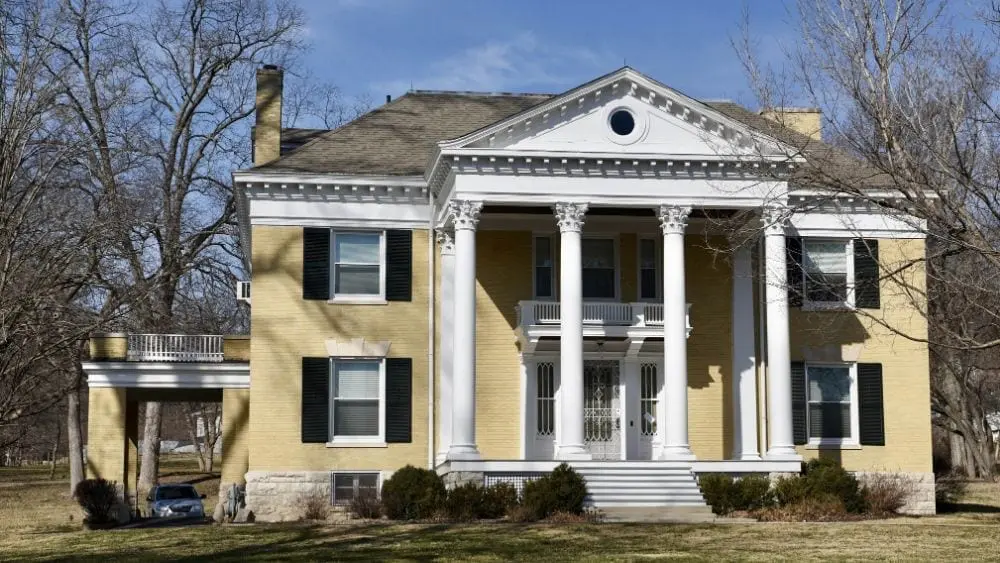The aesthetics of antebellum plantation houses of the South continue to appeal to homeowners for a multitude of reasons. Since these continue to be a fan favorite, let’s take a closer look behind the why.
What is a Greek Revival Style House?
Greek Revival homes began being built around 1810 until the beginning of the Civil War, following the world-wide trend of becoming enamored with ancient Greece. As America prides itself being the descendant of Greece, the birthplace of democracy, Grecian architecture was soon folded into the general population’s interests. Based on ancient Greek temples from 5th Century BCE, these stout and imposing structures are easily recognized by the white columns and gabled roof that make up the front façade. When you take a closer look, though, you can see there’s much more to these homes than these two features.
What Makes a House Greek Revival?

Several exterior features – most very easy to spot – make a Greek Revival home identifiable.
Columns & Pediments
Eye-catching and functional, columns and pilasters are a staple of Greek Revival architecture. Reminiscent of the columns found on Grecian structures such as the Parthenon and the Temple of Aphaia, these features add to the imposing and larger-than-life aesthetic for which these homes are known. They are often painted white to mimic the white marble of Grecian architecture.
The other part of this façade, the pointy triangle at the top? That’s the pediment, not strictly necessary but often included to protect windows and doors from inclement weather.
Gabled or Hipped Rooves
Gabled rooves – iconic of the Craftsman style – are the most common aesthetic style of rooftops on American homes today, largely due to the practicality of their design: The steep angle of the roof means snow and rain easily slide off, preventing buildup that could cause the roof to collapse.
Hipped rooves, which is what’s shown behind the pediment in the photo above, are another common option for Greek Revival homes.
Transom & Sidelights
The entrance of a home is not the time to skimp on grandeur, according to Greek Revivalists. Framing the front door on either side are rectangular sidelights: Windows with ornate trim and design. Across the top is a transom, typically matching the design of the sidelights.
The windows and door are often recessed to add depth to the front of the house, and the trim is wide and almost always painted white.
Porch or Portico
Almost any home style that’s common in the southern United States features some sort of porch as a finishing touch, and Greek Revivals are no different. Whether a porch – a feature that extends along the face of the house – or a portico, which is just a small porch directly in front of the main entrance, these are a staple.
Because the Grecian columns make these homes stand out, typically they run the full perimeter of the porch, even if it wraps completely around the house. Given the varying weather in the southern region of the U.S., spacious porches are popular as they allow homeowners to enjoy the outdoors.
And what about inside these homes? Well, there are staples there as well.
Hardwood Floors
Wood floors were common in older Greek structures, and Greek Revivals kept the trend going. Dark, hardwood floors add to the overall grandeur of the home, and as carpet didn’t become common until the 1950s, wood was the typical sight to see.
Cornices & Trim
The decorative trim and design that we see on the columns and around the entrance of Greek Revivals is also brought inside, usually in cornices along the upper edge of interior walls or trim used to make faux panels. While elegant, these features are not meant to overwhelm a space or be so intense as to distract from the overall room; in traditional Greek Revivals, trim and cornices are painted to match the interior walls of the home.
Neutral Colors
Greek Revival homes utilize neutral colors throughout the interior: White trim and white walls and white framing is not uncommon to see in one of these homes. Modern adaptions are fond of using more color – there’s even the contemporary trend of painting walls dark, saturated colors – so don’t feel like you have to stick with the basics to be true to the style.
Bring Back the Style
The larger-than-life vibe of these homes is highly desirable for good reason: At their core, the architecture of Greek Revivals is clean and grand without being overwhelming. Even as times change, these homes will continue to be popular.
Ready to find your new home, or just want a bit of inspiration? Follow us on social media!

Kian Zozobrado joined Builders Digital Experience (BDX) in 2019 as a content writer. A graduate of Southwestern University with a degree in English, Kian is passionate about the written word and making connections. Outside of work, Kian also serves as president of the Board of Directors for the Writers’ League of Texas.
 Home Style Guide: Dutch Colonial
Home Style Guide: Dutch Colonial